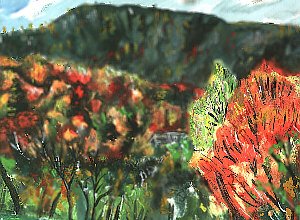|
Coming out from the Bonskeid area eastwards towards the A9 corridor entails crossing the Garry Bridge at the end of the Rannoch Moor (eventually a dead end) to the near Pitlochry road. Looking north from the Garry Bridge high above that river is to look into the Pass of Killiecrankie. This is a vital pass in the geography of Scotland and is so because it runs south to north, unlike many which run east to west. This is important for the movement of wildlife and human traffic alike. The Pass of Killiecrankie is also a largely self-contained area, and become a Site of Special Scientific Interest, with still a healthy population of red quirrels and contains some rare noted species of insect life. More obviously than this, it is a remnant of the natural woodland of the area, although today this means cutting down the trees originally imported like Birch which exposes the forest floor to regeneration of local tree species. As at Bonskeid, control is needed to keep things natural.
|
 I visited twice in October 2000. The first time was for a highly informative Fruits of the Forest nature walk given by two rangers, and secondly to paint the view across the valley in a very rushed painting taking only an hour (here digitally enhanced!). I visited twice in October 2000. The first time was for a highly informative Fruits of the Forest nature walk given by two rangers, and secondly to paint the view across the valley in a very rushed painting taking only an hour (here digitally enhanced!).
|
|
The Pass was increased in size by the ice sheets which gouged through the valley but normally had little effect against the granite around, thus retaining a narrow appearance, and it was after this period 10,000 years ago that woodland generated itself.
|
|
Originally a local track ran through at the river side. The Duke of Atholl passed through it taking three days by sedan chair between Dunkeld and Blair Atholl. The Jacobite uprisings (there was a battle in Killiecrankie in 1689) led a new road to be built in the approximate area of the old A9 (now B8079) by General Wade in 1728 to get through to the renogade locals. Thomas Telford created the A9 (as would be) as part of a network built between 1804 and 1824. The railway came through the pass on a 10 arch viaduct but lower than the old A9 in 1863. Then in the 1980's the new A9 stretched from Perth to Inverness coming through the pass at the highest level.
|
|
As for the road to and from Bonskeid and beyond, this was once joined only by a ferry across the Garry river. In 1770 a bridge was built at the river level after an accident. This was demolished in 1955 sometime after its replacement by a Bailey bridge. In 1968 the Garry Bridge was put up for traffic at the high level of the then A9, with a footbridge put up at the low level of the arched bridge. The existence of all this traffic has not polluted the area unduly with fumes and the air remains fresh and clean for the plant and animal life.
|
|
In Spring willow buds open and the many hazels flower. Flowers burst out on the wooland floor before the trees create a covering. White wood anemones, wood sorrel, lesser celandine, violets, cowslips and primroses (especially near birch trees) appear. Birds noisily establish territories, with tits, finches, blackbirds, wrens and robins among around 40 species.
|
|
Migrant birds arrive in summer, starting with the willow warbler and then the populous wood warbler and flycatchers arrive during May. Bats like the birds enjoy the insect food available.
|
|
In autumn comes the rich variety of colours of woodland, and must be the best time to visit with some remaining greens (a few evergreens) set against varieties of orange and yellow. The fruits/ seeds abound, with ash keys, beech, hazelnuts, rowan berries and acorns. The red squirrels are at their most populous. Red squirrels (unlike the grey who will keep looking and eating) store their nuts, and jays store acorns, and these storage methods actually help spread the seeds and spread of the tree species. Fungi are also food, and part of the decomposing transition of the forest on the deadwood. There are buzards and goosander and salmon may leap at the falls.
|
|
In winter the trees are largely bare. Wrens, robins, heron, siskin, redwing and the white bibbed dipper live within the area. Deer, squirrels, other small mammals and the otter leave traces of their activity.
|
 I visited twice in October 2000. The first time was for a highly informative Fruits of the Forest nature walk given by two rangers, and secondly to paint the view across the valley in a very rushed painting taking only an hour (here digitally enhanced!).
I visited twice in October 2000. The first time was for a highly informative Fruits of the Forest nature walk given by two rangers, and secondly to paint the view across the valley in a very rushed painting taking only an hour (here digitally enhanced!).